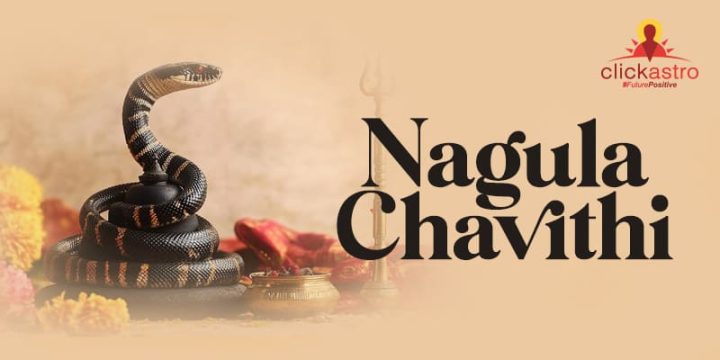Contents[hide]
Introduction
The festival of Nagula Chavithi is dedicated to the worship of serpents and is celebrated with devotion across southern states of India, particularly in Andhra Pradesh, Telangana, and Karnataka. This auspicious festival falls on the fourth day (Chavithi) after Amavasya (new moon) during the Kartika month of the lunar calendar. Rooted deeply in spiritual and ecological beliefs, Nagula Chavithi honors serpents not only as divine beings but also as symbols of fertility, protection, and prosperity. Traditionally observed by married women, the festival includes fasting, rituals, and prayers for the well-being of their children and family. Farmers, too, participate with great reverence, recognizing the role of snakes in maintaining ecological balance by controlling the rodent population, which helps in agricultural prosperity. Beyond material benefits, the festival promotes harmony with nature and is believed to cleanse spiritual impurities. Through various customs, devotees seek the blessings of Nagas, hoping for protection, happiness, and abundance in their lives.Date and Time of Nagula Chavithi 2024
Devotees typically perform pujas early in the morning or at noon, as this is considered the most auspicious time to offer prayers to the serpent gods (Nagas).In 2024, Nagula Chavithi will be celebrated on:
Date: November 5, 2024 (Tuesday)
Muhurta: 10:59 AM – 1:10 PM
The Significance of Nagula Chavithi
Nagula Chavithi holds profound spiritual and ecological importance. It emphasizes the worship of serpents (Nagas), who are regarded as divine beings and protectors of the underworld (Patala). Snakes are also honored as symbols of fertility, prosperity, and protection. The festival reflects a deep connection between humans and nature, promoting ecological harmony while addressing spiritual beliefs.Agricultural Prosperity
In agrarian societies, snakes play a crucial role in maintaining ecological balance by controlling the rodent population, which can damage crops. Farmers express gratitude by worshipping Nagas, seeking their blessings for a bountiful harvest. The festival takes place during the Kartika month, aligning with the agricultural calendar.Protection of Family
The festival is primarily observed by married women who undertake fasting and perform rituals for the safety, health, and prosperity of their children and families. This tradition reflects the protective symbolism associated with serpents, who are believed to ward off negative forces.Spiritual Cleansing
Nagula Chavithi is also regarded as an opportunity for spiritual purification. Devotees believe that worshipping Nagas helps cleanse sins and reduce the negative effects of Naga Dosha, an astrological affliction caused by unfavorable alignments linked to serpents.Respect for Nature and Ecological Balance
Nagula Chavithi serves as a reminder to protect forests, animals, and the delicate ecological balance that sustains life. It highlights the need to respect all creatures, especially serpents, whose existence contributes to environmental well-being.The Legend Behind Nagula Chavithi
The origins of Nagula Chavithi are rooted in ancient Vedic texts, particularly the legend of Samudra Manthan (the churning of the cosmic ocean). This pivotal event involved both gods (Devas) and demons (Asuras) working together to churn the ocean to extract the nectar of immortality (Amrit). A divine serpent, Vasuki, was used as the rope in this cosmic endeavor, with Mount Mandara serving as the churning rod. However, during the process, a deadly poison known as Halahala emerged, threatening to destroy the universe with its toxic fumes. To save the cosmos, Lord Shiva selflessly consumed the poison, which lodged in his throat, turning it blue and earning him the title Neelakantha (the blue-throated one). Although Shiva managed to contain the poison, a few drops are said to have fallen to Earth, leading to the fear of serpents as carriers of misfortune. To appease these divine serpents and prevent calamity, people began worshipping them, giving rise to festivals such as Nagula Chavithi.Serpents in ancient times
The significance of serpents extends beyond this tale, as they appear in various forms throughout ancient history, often representing power, protection, and cosmic energy. One of the most prominent associations is with Lord Vishnu, who rests on the thousand-headed serpent Adishesha (or Ananta), floating on the primordial ocean. The serpent symbolizes eternal time and provides divine protection to Vishnu as he sustains the universe. Similarly, Lord Shiva, the destroyer and transformer, is depicted with a snake coiled around his neck, symbolizing control over fear, death, and the cycle of time. Other deities, such as Lord Subramanya (Kartikeya) and Lord Ganesha, also feature serpent imagery, reflecting their protective powers and spiritual significance. Nagula Chavithi honors these mythical associations with serpents, invoking their blessings for protection, prosperity, and spiritual harmony.Rituals and Traditions of Nagula Chavithi
Nagula Chavithi rituals are deeply symbolic, fostering spiritual connection and ecological reverence. The day begins with preparations that set a pious tone for the festival.Morning Preparations
Devotees start the day with a ritual bath, believed to cleanse both body and mind, helping them approach the divine in a state of purity. Women, in particular, play a prominent role in the day’s observances. They adorn themselves in traditional attire, often wearing sarees or outfits in auspicious colors such as yellow or green, which represent prosperity, joy, and renewal. In many households, a prayer area is designated, typically adorned with flowers, lamps, and images or idols of serpents. For devotees living near rural or forested areas, visiting anthills (putta)—believed to be the dwelling places of snakes—is an essential tradition. These anthills are decorated with turmeric, vermillion, flowers, and offerings of milk, rice, and sweets to invoke the blessings of the divine serpents.Installation of Naga Idols
A central aspect of Nagula Chavithi is the installation of snake idols, symbolizing the presence of divine serpents. These idols are crafted from clay, stone, or silver and are placed on altars at home, in courtyards, or near water bodies. The altars are decorated with lamps, flowers, and incense, creating a sacred atmosphere. In rural areas, devotees prefer to visit anthills or temples where permanent Naga Pratimas (serpent idols) are installed. These installations are often under peepal or banyan trees, revered for their spiritual significance and association with Lord Vishnu and serpent deities.Offerings to the Snake Deity
The ritual offerings reflect the festival’s devotional spirit. Milk, turmeric, kumkum (vermilion), fruits, sesame laddoos, and special delicacies like chalimidi—a sweet dish made from rice flour and jaggery—are placed before the Naga idols. One of the key traditions involves pouring milk into snake pits or over the idols, as it is believed to appease the Nagas and invite prosperity. In some regional customs, non-vegetarian offerings like eggs are presented at anthills, although this practice is now discouraged.Mantras and Prayers
Chanting mantras is a vital part of the rituals, invoking the blessings of serpent gods for protection and well-being. The Naga Gayatri Mantra is commonly recited, along with prayers addressing individual serpent deities:Mantras:
Om Naagaraajaya Vidmaheor
Chak-shush-sravanaaya Dhiimahi
Thanno Sarpa Prachodayaath
Om Nava-kulaaya Vidmahe
Visha-danthaaye Dhiimahi
Thanno Sarpa Prachodayaath








